NSB305 Assessment 2: Safe Person-Centred Care in Nursing
VerifiedAdded on 2022/10/13
|7
|1619
|12
Report
AI Summary
This report delves into the critical aspects of providing effective and safe nursing care, focusing on the challenges faced by graduate nurses in achieving safe, person-centred care. It identifies key issues such as resource shortages, weak staff professionalism, unfavorable work environments, insufficient leadership, and non-supportive management. The report provides a detailed discussion of these challenges and their implications, both short-term and long-term, for patient safety and the delivery of care. Furthermore, it suggests practical strategies for addressing these issues, including valuing staff, care planning, building better work environments, and fostering strong relationships. The report emphasizes the importance of safe person-centred care and provides recommendations to create a more supportive and effective healthcare system.
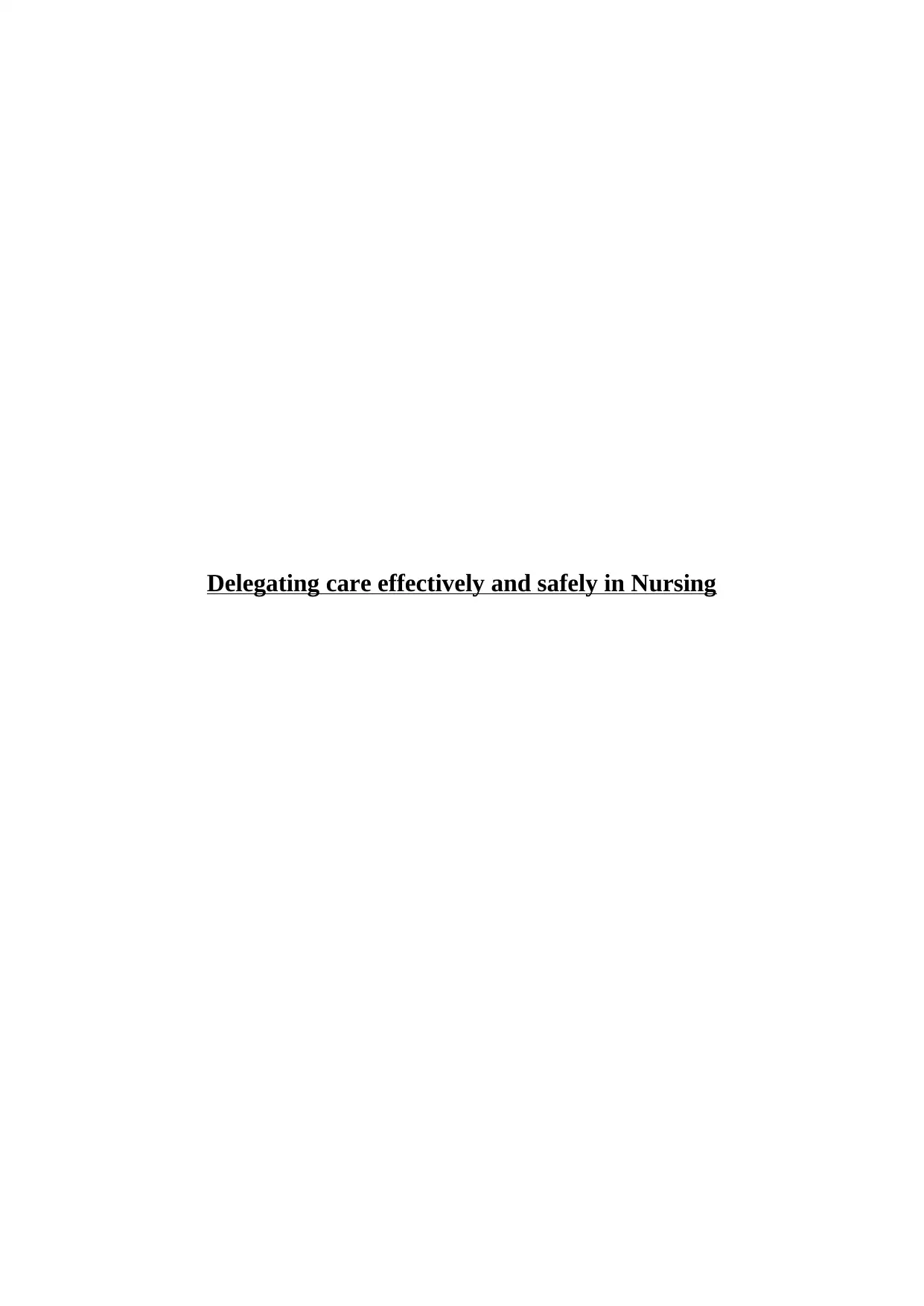
Delegating care effectively and safely in Nursing
Paraphrase This Document
Need a fresh take? Get an instant paraphrase of this document with our AI Paraphraser
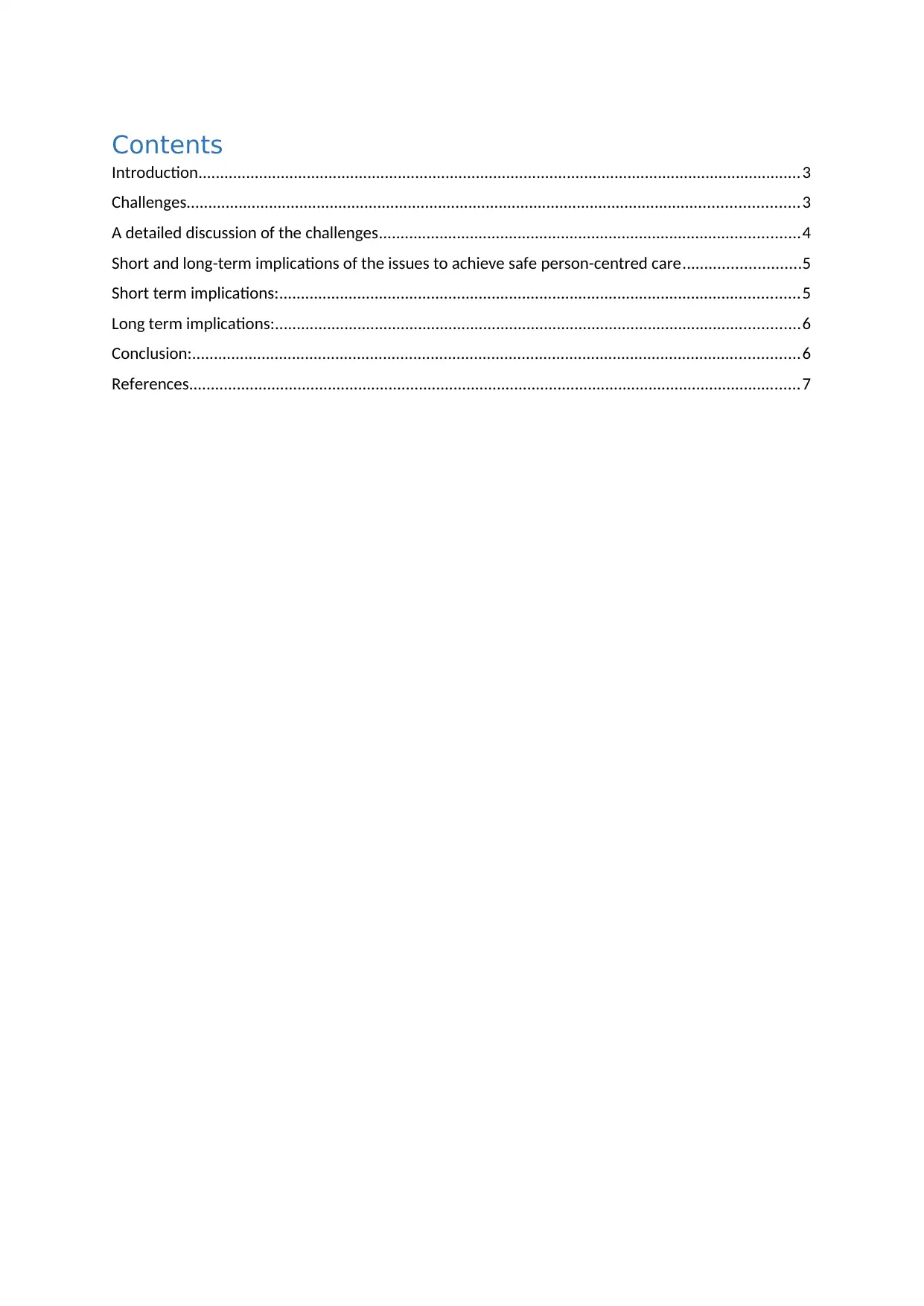
Contents
Introduction...........................................................................................................................................3
Challenges.............................................................................................................................................3
A detailed discussion of the challenges.................................................................................................4
Short and long-term implications of the issues to achieve safe person-centred care...........................5
Short term implications:........................................................................................................................5
Long term implications:.........................................................................................................................6
Conclusion:............................................................................................................................................6
References.............................................................................................................................................7
Introduction...........................................................................................................................................3
Challenges.............................................................................................................................................3
A detailed discussion of the challenges.................................................................................................4
Short and long-term implications of the issues to achieve safe person-centred care...........................5
Short term implications:........................................................................................................................5
Long term implications:.........................................................................................................................6
Conclusion:............................................................................................................................................6
References.............................................................................................................................................7
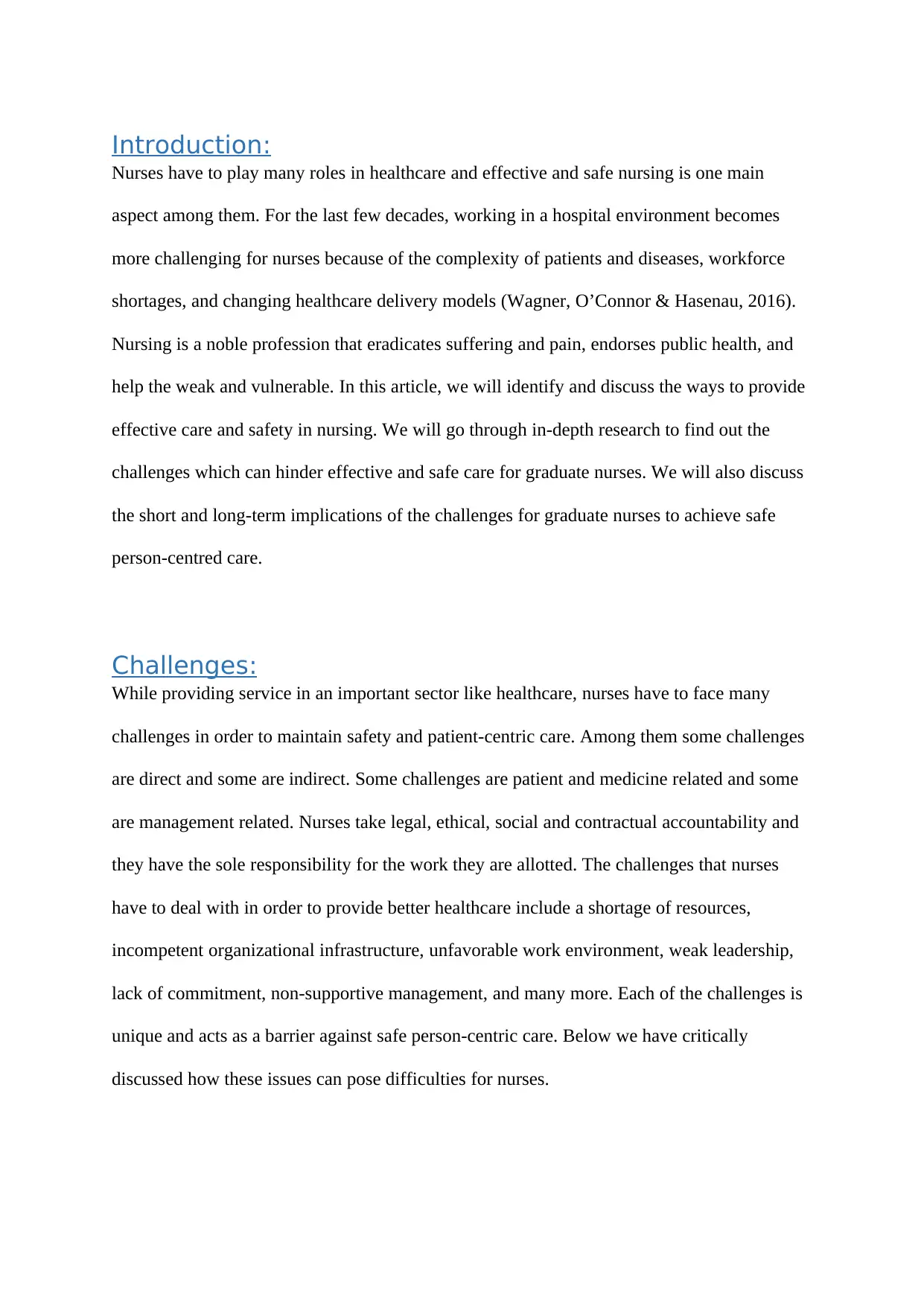
Introduction:
Nurses have to play many roles in healthcare and effective and safe nursing is one main
aspect among them. For the last few decades, working in a hospital environment becomes
more challenging for nurses because of the complexity of patients and diseases, workforce
shortages, and changing healthcare delivery models (Wagner, O’Connor & Hasenau, 2016).
Nursing is a noble profession that eradicates suffering and pain, endorses public health, and
help the weak and vulnerable. In this article, we will identify and discuss the ways to provide
effective care and safety in nursing. We will go through in-depth research to find out the
challenges which can hinder effective and safe care for graduate nurses. We will also discuss
the short and long-term implications of the challenges for graduate nurses to achieve safe
person-centred care.
Challenges:
While providing service in an important sector like healthcare, nurses have to face many
challenges in order to maintain safety and patient-centric care. Among them some challenges
are direct and some are indirect. Some challenges are patient and medicine related and some
are management related. Nurses take legal, ethical, social and contractual accountability and
they have the sole responsibility for the work they are allotted. The challenges that nurses
have to deal with in order to provide better healthcare include a shortage of resources,
incompetent organizational infrastructure, unfavorable work environment, weak leadership,
lack of commitment, non-supportive management, and many more. Each of the challenges is
unique and acts as a barrier against safe person-centric care. Below we have critically
discussed how these issues can pose difficulties for nurses.
Nurses have to play many roles in healthcare and effective and safe nursing is one main
aspect among them. For the last few decades, working in a hospital environment becomes
more challenging for nurses because of the complexity of patients and diseases, workforce
shortages, and changing healthcare delivery models (Wagner, O’Connor & Hasenau, 2016).
Nursing is a noble profession that eradicates suffering and pain, endorses public health, and
help the weak and vulnerable. In this article, we will identify and discuss the ways to provide
effective care and safety in nursing. We will go through in-depth research to find out the
challenges which can hinder effective and safe care for graduate nurses. We will also discuss
the short and long-term implications of the challenges for graduate nurses to achieve safe
person-centred care.
Challenges:
While providing service in an important sector like healthcare, nurses have to face many
challenges in order to maintain safety and patient-centric care. Among them some challenges
are direct and some are indirect. Some challenges are patient and medicine related and some
are management related. Nurses take legal, ethical, social and contractual accountability and
they have the sole responsibility for the work they are allotted. The challenges that nurses
have to deal with in order to provide better healthcare include a shortage of resources,
incompetent organizational infrastructure, unfavorable work environment, weak leadership,
lack of commitment, non-supportive management, and many more. Each of the challenges is
unique and acts as a barrier against safe person-centric care. Below we have critically
discussed how these issues can pose difficulties for nurses.
⊘ This is a preview!⊘
Do you want full access?
Subscribe today to unlock all pages.

Trusted by 1+ million students worldwide
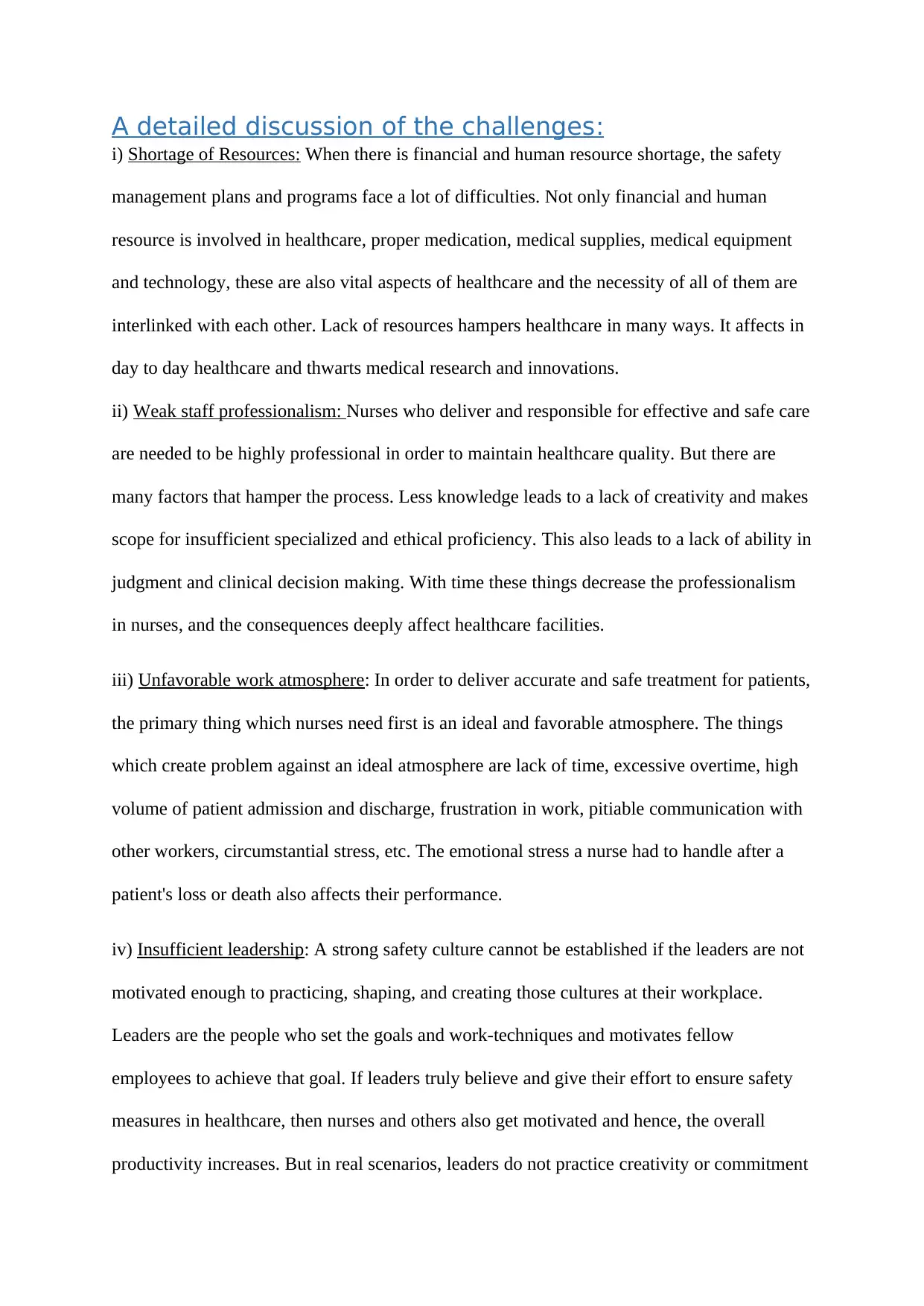
A detailed discussion of the challenges:
i) Shortage of Resources: When there is financial and human resource shortage, the safety
management plans and programs face a lot of difficulties. Not only financial and human
resource is involved in healthcare, proper medication, medical supplies, medical equipment
and technology, these are also vital aspects of healthcare and the necessity of all of them are
interlinked with each other. Lack of resources hampers healthcare in many ways. It affects in
day to day healthcare and thwarts medical research and innovations.
ii) Weak staff professionalism: Nurses who deliver and responsible for effective and safe care
are needed to be highly professional in order to maintain healthcare quality. But there are
many factors that hamper the process. Less knowledge leads to a lack of creativity and makes
scope for insufficient specialized and ethical proficiency. This also leads to a lack of ability in
judgment and clinical decision making. With time these things decrease the professionalism
in nurses, and the consequences deeply affect healthcare facilities.
iii) Unfavorable work atmosphere: In order to deliver accurate and safe treatment for patients,
the primary thing which nurses need first is an ideal and favorable atmosphere. The things
which create problem against an ideal atmosphere are lack of time, excessive overtime, high
volume of patient admission and discharge, frustration in work, pitiable communication with
other workers, circumstantial stress, etc. The emotional stress a nurse had to handle after a
patient's loss or death also affects their performance.
iv) Insufficient leadership: A strong safety culture cannot be established if the leaders are not
motivated enough to practicing, shaping, and creating those cultures at their workplace.
Leaders are the people who set the goals and work-techniques and motivates fellow
employees to achieve that goal. If leaders truly believe and give their effort to ensure safety
measures in healthcare, then nurses and others also get motivated and hence, the overall
productivity increases. But in real scenarios, leaders do not practice creativity or commitment
i) Shortage of Resources: When there is financial and human resource shortage, the safety
management plans and programs face a lot of difficulties. Not only financial and human
resource is involved in healthcare, proper medication, medical supplies, medical equipment
and technology, these are also vital aspects of healthcare and the necessity of all of them are
interlinked with each other. Lack of resources hampers healthcare in many ways. It affects in
day to day healthcare and thwarts medical research and innovations.
ii) Weak staff professionalism: Nurses who deliver and responsible for effective and safe care
are needed to be highly professional in order to maintain healthcare quality. But there are
many factors that hamper the process. Less knowledge leads to a lack of creativity and makes
scope for insufficient specialized and ethical proficiency. This also leads to a lack of ability in
judgment and clinical decision making. With time these things decrease the professionalism
in nurses, and the consequences deeply affect healthcare facilities.
iii) Unfavorable work atmosphere: In order to deliver accurate and safe treatment for patients,
the primary thing which nurses need first is an ideal and favorable atmosphere. The things
which create problem against an ideal atmosphere are lack of time, excessive overtime, high
volume of patient admission and discharge, frustration in work, pitiable communication with
other workers, circumstantial stress, etc. The emotional stress a nurse had to handle after a
patient's loss or death also affects their performance.
iv) Insufficient leadership: A strong safety culture cannot be established if the leaders are not
motivated enough to practicing, shaping, and creating those cultures at their workplace.
Leaders are the people who set the goals and work-techniques and motivates fellow
employees to achieve that goal. If leaders truly believe and give their effort to ensure safety
measures in healthcare, then nurses and others also get motivated and hence, the overall
productivity increases. But in real scenarios, leaders do not practice creativity or commitment
Paraphrase This Document
Need a fresh take? Get an instant paraphrase of this document with our AI Paraphraser
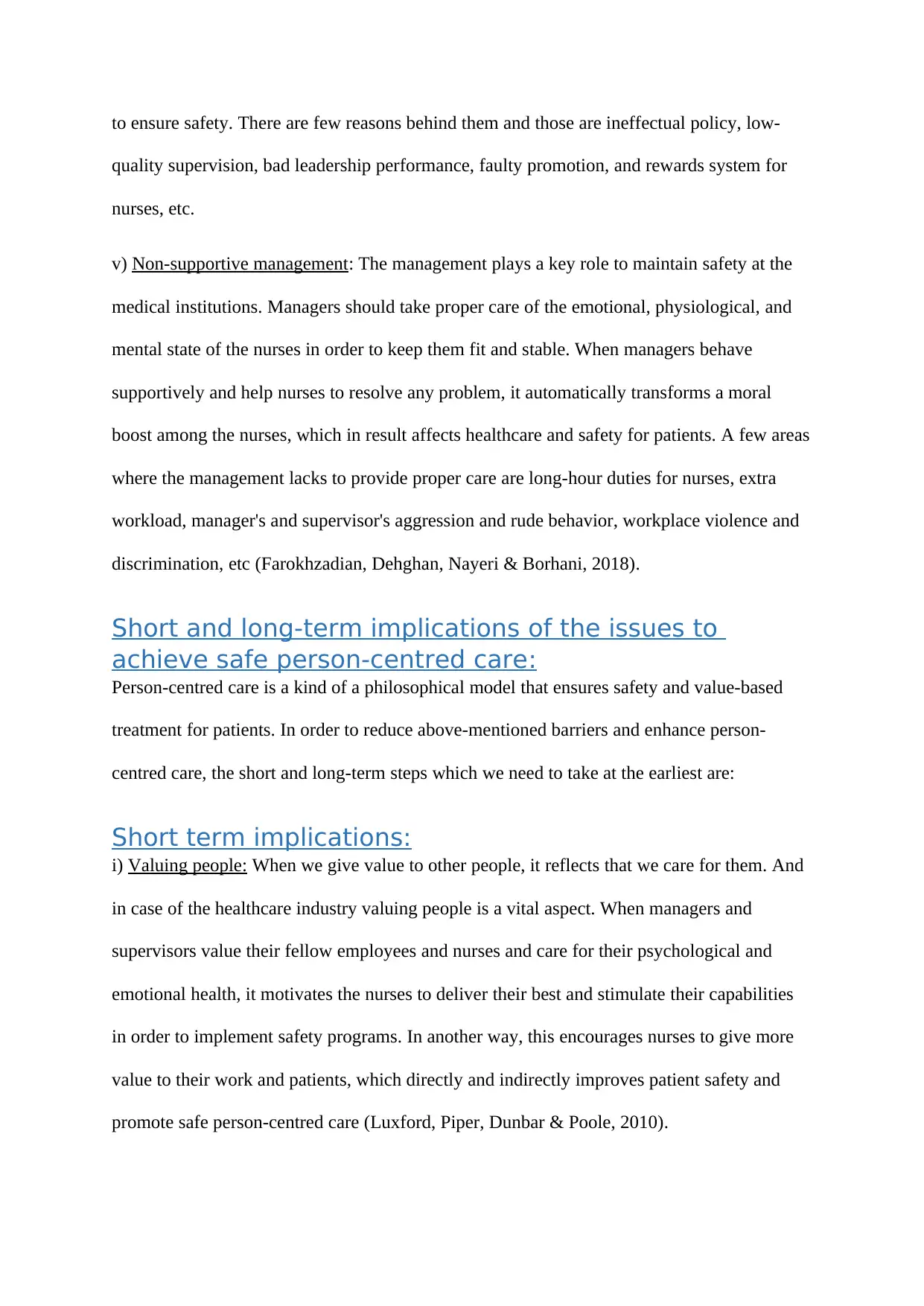
to ensure safety. There are few reasons behind them and those are ineffectual policy, low-
quality supervision, bad leadership performance, faulty promotion, and rewards system for
nurses, etc.
v) Non-supportive management: The management plays a key role to maintain safety at the
medical institutions. Managers should take proper care of the emotional, physiological, and
mental state of the nurses in order to keep them fit and stable. When managers behave
supportively and help nurses to resolve any problem, it automatically transforms a moral
boost among the nurses, which in result affects healthcare and safety for patients. A few areas
where the management lacks to provide proper care are long-hour duties for nurses, extra
workload, manager's and supervisor's aggression and rude behavior, workplace violence and
discrimination, etc (Farokhzadian, Dehghan, Nayeri & Borhani, 2018).
Short and long-term implications of the issues to
achieve safe person-centred care:
Person-centred care is a kind of a philosophical model that ensures safety and value-based
treatment for patients. In order to reduce above-mentioned barriers and enhance person-
centred care, the short and long-term steps which we need to take at the earliest are:
Short term implications:
i) Valuing people: When we give value to other people, it reflects that we care for them. And
in case of the healthcare industry valuing people is a vital aspect. When managers and
supervisors value their fellow employees and nurses and care for their psychological and
emotional health, it motivates the nurses to deliver their best and stimulate their capabilities
in order to implement safety programs. In another way, this encourages nurses to give more
value to their work and patients, which directly and indirectly improves patient safety and
promote safe person-centred care (Luxford, Piper, Dunbar & Poole, 2010).
quality supervision, bad leadership performance, faulty promotion, and rewards system for
nurses, etc.
v) Non-supportive management: The management plays a key role to maintain safety at the
medical institutions. Managers should take proper care of the emotional, physiological, and
mental state of the nurses in order to keep them fit and stable. When managers behave
supportively and help nurses to resolve any problem, it automatically transforms a moral
boost among the nurses, which in result affects healthcare and safety for patients. A few areas
where the management lacks to provide proper care are long-hour duties for nurses, extra
workload, manager's and supervisor's aggression and rude behavior, workplace violence and
discrimination, etc (Farokhzadian, Dehghan, Nayeri & Borhani, 2018).
Short and long-term implications of the issues to
achieve safe person-centred care:
Person-centred care is a kind of a philosophical model that ensures safety and value-based
treatment for patients. In order to reduce above-mentioned barriers and enhance person-
centred care, the short and long-term steps which we need to take at the earliest are:
Short term implications:
i) Valuing people: When we give value to other people, it reflects that we care for them. And
in case of the healthcare industry valuing people is a vital aspect. When managers and
supervisors value their fellow employees and nurses and care for their psychological and
emotional health, it motivates the nurses to deliver their best and stimulate their capabilities
in order to implement safety programs. In another way, this encourages nurses to give more
value to their work and patients, which directly and indirectly improves patient safety and
promote safe person-centred care (Luxford, Piper, Dunbar & Poole, 2010).
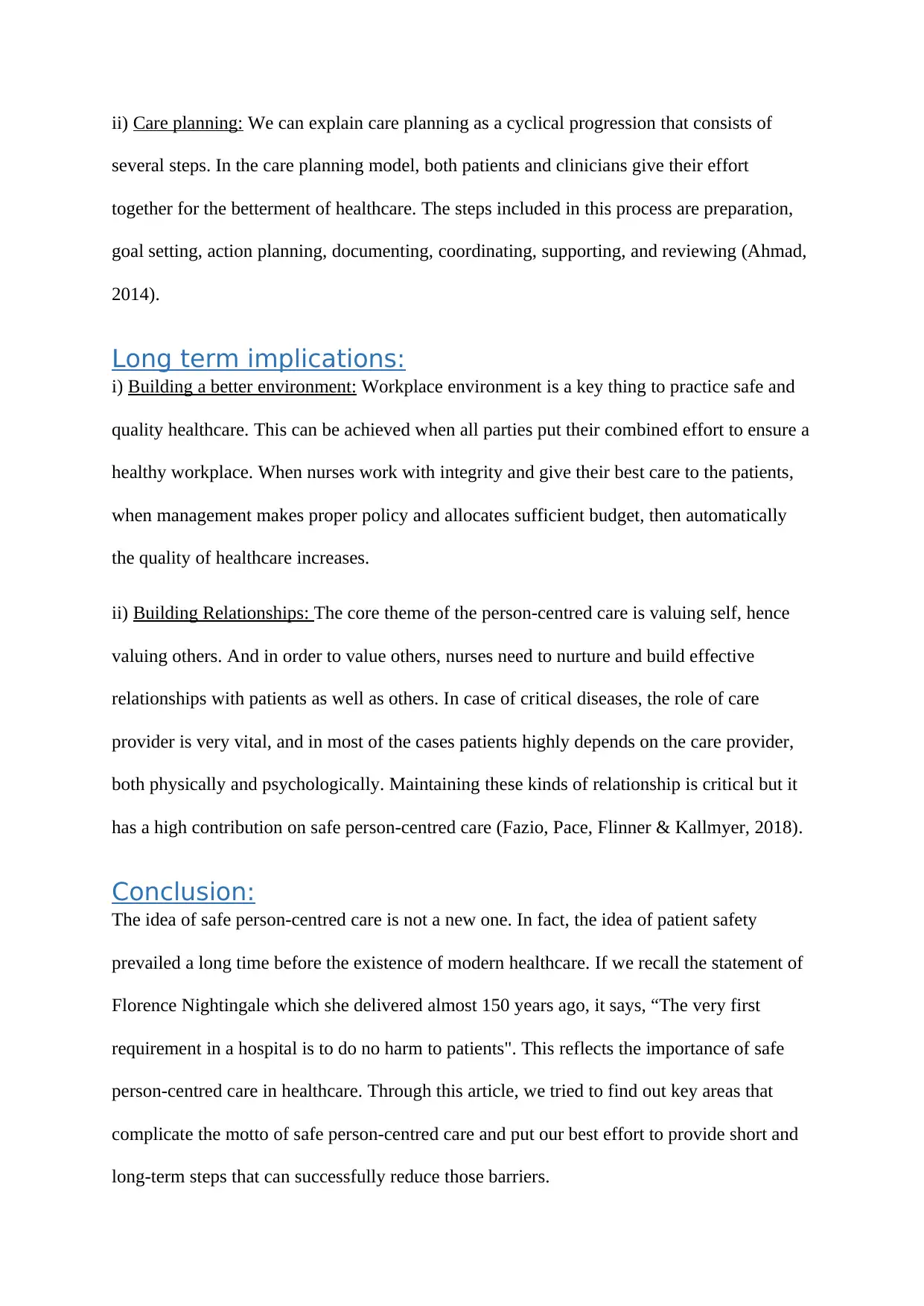
ii) Care planning: We can explain care planning as a cyclical progression that consists of
several steps. In the care planning model, both patients and clinicians give their effort
together for the betterment of healthcare. The steps included in this process are preparation,
goal setting, action planning, documenting, coordinating, supporting, and reviewing (Ahmad,
2014).
Long term implications:
i) Building a better environment: Workplace environment is a key thing to practice safe and
quality healthcare. This can be achieved when all parties put their combined effort to ensure a
healthy workplace. When nurses work with integrity and give their best care to the patients,
when management makes proper policy and allocates sufficient budget, then automatically
the quality of healthcare increases.
ii) Building Relationships: The core theme of the person-centred care is valuing self, hence
valuing others. And in order to value others, nurses need to nurture and build effective
relationships with patients as well as others. In case of critical diseases, the role of care
provider is very vital, and in most of the cases patients highly depends on the care provider,
both physically and psychologically. Maintaining these kinds of relationship is critical but it
has a high contribution on safe person-centred care (Fazio, Pace, Flinner & Kallmyer, 2018).
Conclusion:
The idea of safe person-centred care is not a new one. In fact, the idea of patient safety
prevailed a long time before the existence of modern healthcare. If we recall the statement of
Florence Nightingale which she delivered almost 150 years ago, it says, “The very first
requirement in a hospital is to do no harm to patients". This reflects the importance of safe
person-centred care in healthcare. Through this article, we tried to find out key areas that
complicate the motto of safe person-centred care and put our best effort to provide short and
long-term steps that can successfully reduce those barriers.
several steps. In the care planning model, both patients and clinicians give their effort
together for the betterment of healthcare. The steps included in this process are preparation,
goal setting, action planning, documenting, coordinating, supporting, and reviewing (Ahmad,
2014).
Long term implications:
i) Building a better environment: Workplace environment is a key thing to practice safe and
quality healthcare. This can be achieved when all parties put their combined effort to ensure a
healthy workplace. When nurses work with integrity and give their best care to the patients,
when management makes proper policy and allocates sufficient budget, then automatically
the quality of healthcare increases.
ii) Building Relationships: The core theme of the person-centred care is valuing self, hence
valuing others. And in order to value others, nurses need to nurture and build effective
relationships with patients as well as others. In case of critical diseases, the role of care
provider is very vital, and in most of the cases patients highly depends on the care provider,
both physically and psychologically. Maintaining these kinds of relationship is critical but it
has a high contribution on safe person-centred care (Fazio, Pace, Flinner & Kallmyer, 2018).
Conclusion:
The idea of safe person-centred care is not a new one. In fact, the idea of patient safety
prevailed a long time before the existence of modern healthcare. If we recall the statement of
Florence Nightingale which she delivered almost 150 years ago, it says, “The very first
requirement in a hospital is to do no harm to patients". This reflects the importance of safe
person-centred care in healthcare. Through this article, we tried to find out key areas that
complicate the motto of safe person-centred care and put our best effort to provide short and
long-term steps that can successfully reduce those barriers.
⊘ This is a preview!⊘
Do you want full access?
Subscribe today to unlock all pages.

Trusted by 1+ million students worldwide
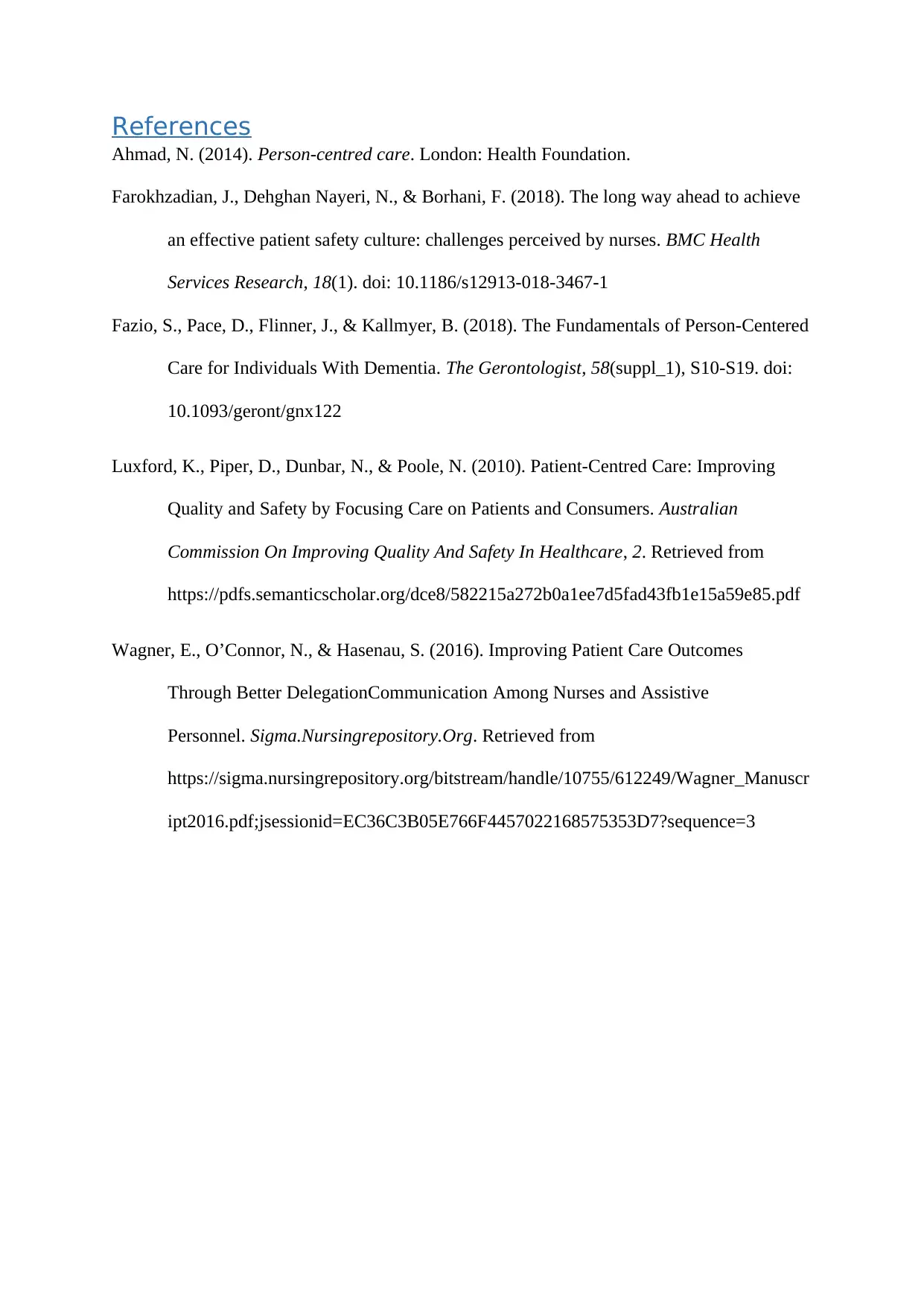
References
Ahmad, N. (2014). Person-centred care. London: Health Foundation.
Farokhzadian, J., Dehghan Nayeri, N., & Borhani, F. (2018). The long way ahead to achieve
an effective patient safety culture: challenges perceived by nurses. BMC Health
Services Research, 18(1). doi: 10.1186/s12913-018-3467-1
Fazio, S., Pace, D., Flinner, J., & Kallmyer, B. (2018). The Fundamentals of Person-Centered
Care for Individuals With Dementia. The Gerontologist, 58(suppl_1), S10-S19. doi:
10.1093/geront/gnx122
Luxford, K., Piper, D., Dunbar, N., & Poole, N. (2010). Patient-Centred Care: Improving
Quality and Safety by Focusing Care on Patients and Consumers. Australian
Commission On Improving Quality And Safety In Healthcare, 2. Retrieved from
https://pdfs.semanticscholar.org/dce8/582215a272b0a1ee7d5fad43fb1e15a59e85.pdf
Wagner, E., O’Connor, N., & Hasenau, S. (2016). Improving Patient Care Outcomes
Through Better DelegationCommunication Among Nurses and Assistive
Personnel. Sigma.Nursingrepository.Org. Retrieved from
https://sigma.nursingrepository.org/bitstream/handle/10755/612249/Wagner_Manuscr
ipt2016.pdf;jsessionid=EC36C3B05E766F4457022168575353D7?sequence=3
Ahmad, N. (2014). Person-centred care. London: Health Foundation.
Farokhzadian, J., Dehghan Nayeri, N., & Borhani, F. (2018). The long way ahead to achieve
an effective patient safety culture: challenges perceived by nurses. BMC Health
Services Research, 18(1). doi: 10.1186/s12913-018-3467-1
Fazio, S., Pace, D., Flinner, J., & Kallmyer, B. (2018). The Fundamentals of Person-Centered
Care for Individuals With Dementia. The Gerontologist, 58(suppl_1), S10-S19. doi:
10.1093/geront/gnx122
Luxford, K., Piper, D., Dunbar, N., & Poole, N. (2010). Patient-Centred Care: Improving
Quality and Safety by Focusing Care on Patients and Consumers. Australian
Commission On Improving Quality And Safety In Healthcare, 2. Retrieved from
https://pdfs.semanticscholar.org/dce8/582215a272b0a1ee7d5fad43fb1e15a59e85.pdf
Wagner, E., O’Connor, N., & Hasenau, S. (2016). Improving Patient Care Outcomes
Through Better DelegationCommunication Among Nurses and Assistive
Personnel. Sigma.Nursingrepository.Org. Retrieved from
https://sigma.nursingrepository.org/bitstream/handle/10755/612249/Wagner_Manuscr
ipt2016.pdf;jsessionid=EC36C3B05E766F4457022168575353D7?sequence=3
1 out of 7
Related Documents
Your All-in-One AI-Powered Toolkit for Academic Success.
+13062052269
info@desklib.com
Available 24*7 on WhatsApp / Email
![[object Object]](/_next/static/media/star-bottom.7253800d.svg)
Unlock your academic potential
Copyright © 2020–2025 A2Z Services. All Rights Reserved. Developed and managed by ZUCOL.





